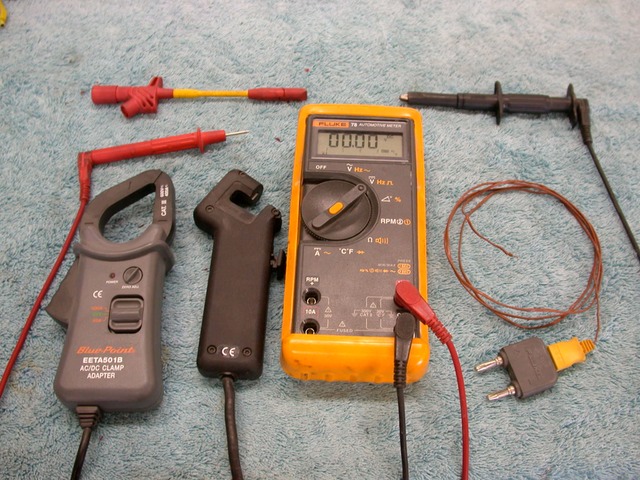
In a pinch, one can get by with test lamps and bits of wire, but with modern technology there really is no reason to do so. An imported multi-meter that tests for voltage and continuity can be had for $10-15. They are cheap enough to toss one into every toolkit you own. (Remember to check the batteries before heading out on a road trip.) A shop-quality tester with voltage, dwell, amperage, temperature, resistance and continuity can be had starting around $50. A professional one that can really take a beating will cost upwards of $300. My FLuke 78 has been dropped, shoved into tool bags and even rained on for over 15 years.
Use them to find wiring faults, test gages, set static distributor timing, test charging systems and batteries. If I had to choose between a good test lamp and a really crappy multimeter, I’d take the meter anytime
Here is a selection of the things a good multimeter can do.
On the left, an inductive amperage clamp will read current flow without interrupting the circuit. This is great for finding that elusive battery drain. (Its probably the radio anyway...) Most meters will read a small current, but only if the leads are in series with the load. This entails interrupting the wiring and only works for very small loads. Anything more than a few amps and the meter's internal fuse will blow. The inductive clamp allows much higher readings without damage to the meter and without disconnecting wires.
Next, a tach adapter. Clip this over a spark plug wire, and you have an accurate tachometer. You can use it to watch engine speed while fiddling in the engine area and can't see the dash, or for checking the calibration on the in-dash tach. Handy, and not very expensive.
On the right, a K-type thermocouple. This particular probe has a "bead" contact. Touch it to a surface, the meter displays the temperature. Check the temperature of thermostat housings, cylinder heads, radiator cores, heater ducts, coolant, etc. My meter displays temperature directly via the thermocouple's plug. If your meter does not have a temperature setting, you can buy a thermocouple adapter that will take a thermocouple signal and generate a voltage that the meter can then display.
On top we have a selection of leads and probes. The black lead has an "alligator" action, opening and closing via the syringe-like grip. It has a large grip range and will stay where you put it. I usually clip to to a good ground. The red lead has a regular solid probe tip. Poke around and see what happens! Above is a "piercing probe" which allows almost non-invasive testing in the middle of a wire run. The lead plugs into the side of the probe handle. The end of the probe has a wedge-like tip for snaking into wire bundles. Once the desired wire is found, the knob on the end is pressed and the hook-like jaw will grab the wire. Releasing the knob will allow a thin needle to pierce the insulation and touch the conductor inside. Once the reading is taken, the wire is released and no damage is done, save for an almost microscopic hole in the insulation.
